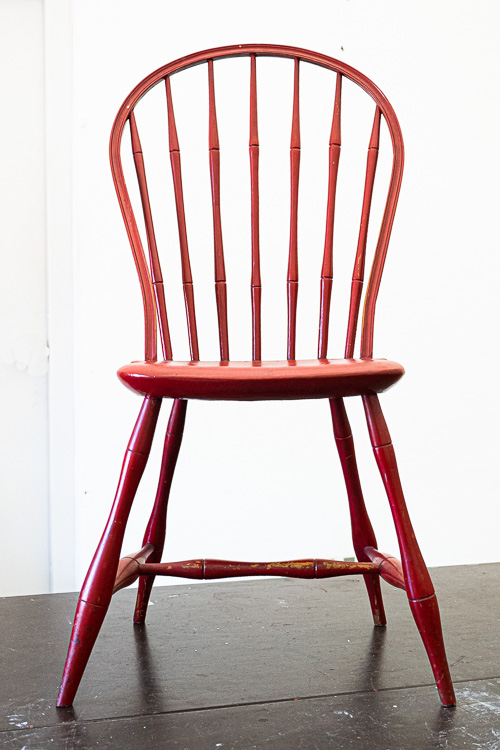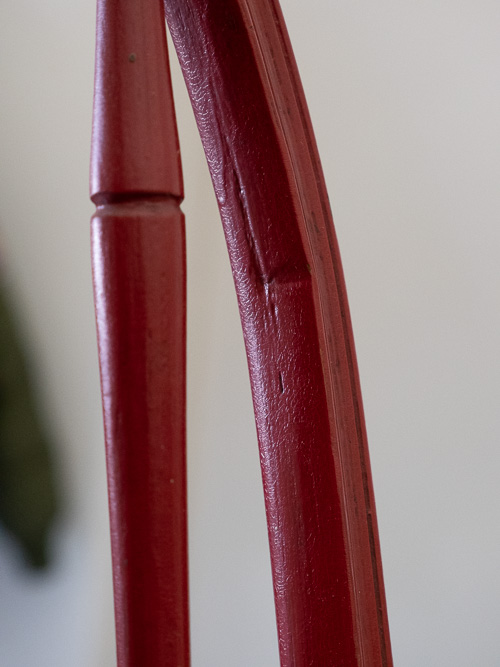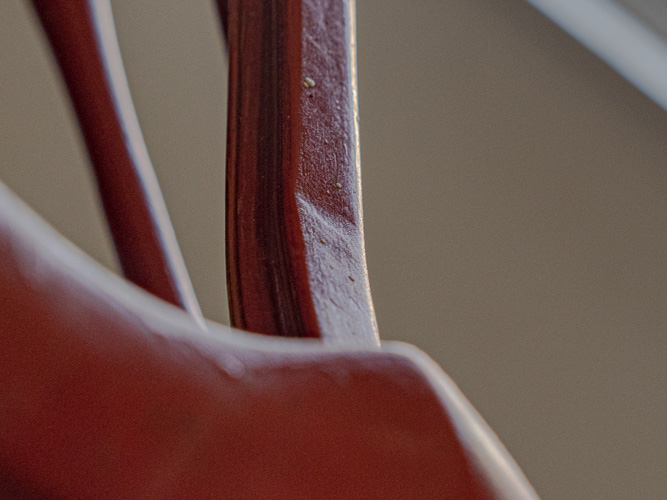I’ve started getting my act together for my book project and I have a couple puzzles to figure out. As a reminder, I’m building two-dozen copies of this chair in Independence Hall’s collection, hopefully in about 140 hours:

Loop back, stamped “WING” at Independence Hall
The chair has four dents in the bow from the bending process. This one (and it’s mirror-image dent) is on the inside of the bow, at it’s widest part:

And this dent is on the outside of the bow down by the seat at the bow’s narrow waist:
 What do they mean? I can think of three options:
What do they mean? I can think of three options:
1. The bow was bent and dried around a single form that bent the top semi-circular bend without denting it, but put the dents into the sides. Possible, but I’m having trouble envisioning what the form would look like. Why would the interior of the bend get dented?
2. Ditto, but after bending, the bow was woven into a drying rack that dented the bow. The drying rack could have three slats on each side of the bend (for a total of six slats), corresponding with the two visible dents in the chair bow and a possible third dent located on the tenon that attaches the bow to the seat. Possibly the bending form would only be a semi-circle for the top of the bow, and the re-curve in the sides of the bow would be created by the drying rack.
3. The dents were created by some sore of freehand bending or “limbering” process while the bow was still hot. I’m doubtful dents in hot steamed wood would stay crisp like the dents in the old chair, but I aim to try it and find out.
Thoughts? Post them on the website comments section. Has anyone seen a bending form or drying rack that like what I’m envisioning in my second option? I’ve seen simpler versions for ladderback and fancy chair crests, like this one pictured in Nancy Goyne Evans Windsor Chairmaking in America, but nothing for a more complex bend:


[…] respaldo en bucle en el Salón de la Independencia de Filadelfia, estampada “WING ”, muestra marcas sutiles en su arco de una forma de flexión o estante de secado, lo que sugiere cómo se […]
Excellent work for creating this kind of content. Thanks for sharing.Kansas City concrete leveling repair
Wow Very inspiring! campbell concrete contractors
Wow Amazing! bathroom remodel ct
[…] the months after I last posted about my book project, I read what remains of Samuel Wing’s account books and spent some time comparing […]
Hello,
Today I’m reading your article it is very different from other blogs and different images share with the help of this blog.
thanks a lot for this article!
Hi, Do you have plans (full scale drawings) for this chair. Its so beautiful!
If you look on Curtis Buchanan’s website, you will find plans for the Loop Back Side Chair.
Is my eye deceiving me or is the bow laminated wood strips rather than bent solid wood?
Laminated? Effectively, yes! But, accomplished by Nature and the growth of the tree. Your eye is detecting the layers of growth rings. The attached image shows a continuous arm bow section with a natural finish.
I think option 2 is very plausible. You could stuff as many bows as will fit in your steam box, pull one out, bend the bow to your form then almost immediately stuff it into the rack you described. This would mean you’d only need a single form and it wouldn’t be tied up for hours per chair. Also, as long as you keep your bent bows square to the slats (and the slats don’t flex) in the drying rack, all of your tenons will be the same angle at the same distance apart. You could bend up as many bows as you like and they might dry quicker with air circulating around all surfaces, unlike being clamped to a form. Period correct? Who knows. Period possible? I think so.
My first thought is similar to your first idea. But I think there are 6 dents. I think the other two are at the bottom of the bow inside the seat. I think they used pegs to form the bending form, with a simple curved surface for the top of the bow. I attached a very simple sketch of how I would do it. The black dots represent posts or pegs on a large flat surface, the triangles are wedges, the brown line is the bent bow, and the large orangish shape would be the only true part of the form. The wedges would hold the wood against the pegs, and keep the outer fibers from splitting. Notice the top of the bow actually has very little curvature. The dents are all where the curves become the steepest. With a peg shape like this, you could theoretically build a very tall form where you can bend a bunch of bows all at once (second picture). I did something like this when I was lazy and didnt fell like building a bending form. I just used the hold fast holes on my work bench, found five that forms a nice even curve, put a one inch dowel in them, and bent the steamed wood around the pegs. I had little dents in mine as well.
I think this has got to be the answer — it was formed around pegs.
Elia, I wonder if the form that was used was more of a flat panel with dowels to create the shape? Imagine a flat panel with two dowels at the bottom holding the narrow part in, those dowels would be on the outside of the hoop, then the other dowels at the wider part and those dowels would be on the inside. With the amount of pressure on those points of contact it is possible that the dents would set in during the drying process. Just a thought.
It seems to me that the dents could be driven by the shape of the bending form. Just below the curved top, the sides of the bow back are straight. If the bending form was just the curved portion, then the sides might have been clamped against the bottom edge of the form.
I’ve seen similar dents in a couple of the rocking chairs I made. I don’t think the steam box I used was hot enough and the wood was too dry, and in one case kiln dried. Maybe those are different but they sure look similar too the ones on my chairs.
Really like your work and your blog, keep it up, it’s inspiring!